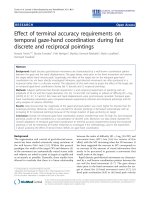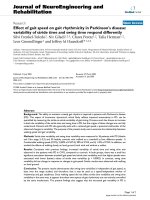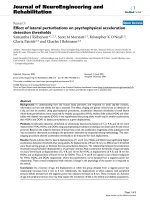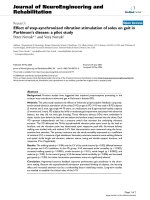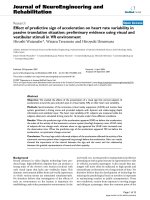Báo cáo hóa học: " Effect of Surfactants on the Structure and Morphology of Magnesium Borate Hydroxide Nanowhiskers Synthesized by Hydrothermal Route" pdf
Bạn đang xem bản rút gọn của tài liệu. Xem và tải ngay bản đầy đủ của tài liệu tại đây (609.09 KB, 9 trang )
NANO EXPRESS
Effect of Surfactants on the Structure and Morphology
of Magnesium Borate Hydroxide Nanowhiskers Synthesized
by Hydrothermal Route
Latha Kumari
•
W. Z. Li
•
Shrinivas Kulkarni
•
K. H. Wu
•
Wei Chen
•
Chunlei Wang
•
Charles H. Vannoy
•
Roger M. Leblanc
Received: 5 August 2009 / Accepted: 26 September 2009 / Published online: 13 October 2009
Ó to the authors 2009
Abstract Magnesium borate hydroxide (MBH) nano-
whiskers were synthesized using a one step hydrothermal
process with different surfactants. The effect surfactants
have on the structure and morphology of the MBH nano-
whiskers has been investigated. The X-ray diffraction
profile confirms that the as-synthesized material is of single
phase, monoclinic MgBO
2
(OH). The variations in the size
and shape of the different MBH nanowhiskers have been
discussed based on the surface morphology analysis. The
annealing of MBH nanowhiskers at 500 °C for 4 h has
significant effect on the crystal structure and surface mor-
phology. The UV–vis absorption spectra of the MBH
nanowhiskers synthesized with and without surfactants
show enhanced absorption in the low-wavelength region,
and their optical band gaps were estimated from the optical
band edge plots. The photoluminescence spectra of the
MBH nanowhiskers produced with and without surfactants
show broad emission band with the peak maximum at
around 400 nm, which confirms the dominant contribution
from the surface defect states.
Keywords Magnesium borate hydroxide Á
Nanowhiskers Á Hydrothermal synthesis Á Surface
morphology Á X-ray diffraction
Introduction
Nanostructured materials have received great interest due
to their fascinating physical, optical, electrical, and ther-
moelectric properties as well as their potential applications
in nanodevices [1–4]. Metal borates are considered among
the most important of these materials because of their
unique properties, such as their light weight, high strength,
high heat-resistance, corrosion-resistance, and high coeffi-
cient of elasticity, etc. Hence, the nanoscale metal borates
are ideal for exploring their potential applications in the
fields of nanocomposites, nanomechanics, and nano-elec-
tronics. Among the various metal borates, aluminum borate
is perhaps the best known ceramic material with chemical
stability, enhanced mechanical properties and potential
applications in high-temperature composites [5]. Magne-
sium borate is another remarkable ceramic material that
shows excellent mechanical and thermal properties.
Magnesium borate hydroxide (MgBO
2
(OH)), also
known as the Szaibelyite, is a widely available translucent
mineral in nature and is used as the main source of boron in
industry [6, 7]. The Szaibelyite is also an important source
of anhydrous magnesium borate [8]. Magnesium borate can
be used as thermo-luminescent phosphor [9], antiwear and
friction reducing additive [10], ferro-elastic material [11],
which is a candidate for tunable laser applications [12], and
can be used as a luminescent material for fluorescent dis-
charge lamps, cathode ray tube screens, and X-ray screens
[13]. Recently variety of magnesium borate nanostructures
such as nanorods [14], nanowires [15, 16], nanobelts [17],
L. Kumari Á W. Z. Li (&)
Department of Physics, Florida International University,
Miami, FL 33199, USA
e-mail: Wenzhi.Li@fiu.edu
S. Kulkarni Á K. H. Wu Á W. Chen Á C. Wang
Department of Mechanical and Materials Engineering,
Florida International University, Miami, FL 33174, USA
C. H. Vannoy Á R. M. Leblanc
Department of Chemistry, University of Miami,
Coral Gables, FL 33124, USA
123
Nanoscale Res Lett (2010) 5:149–157
DOI 10.1007/s11671-009-9457-9
nanoparticles [10] and nanotubes [18] have been fabricated
by different synthesis techniques including thermal evap-
oration, chemical vapor deposition, ethanol supercritical
fluid drying technique, and thermal evaporation in IR-
irradiation heating furnace [10, 14–18]. However, in all
these reported routes, the synthesis was performed at high
temperatures (750–1,100 °C).
The synthesis of nanoparticles with controlled size and
shape results in new electronic and optical properties, which
is suitable for many electronic and optoelectronic applica-
tions [19]. The use of surfactants as stabilizers has advan-
tages with the fact that these surface-active chemicals
possess sufficient strength to effectively control the particle
size growth. The surfactants support to have particles with
‘‘monodisperse’’ size distribution and increased aspect
ratio, and they also effectively prevent the particles from
agglomeration [20–23]. Over the decades, the hydrothermal
process has proved to be one of the most successful methods
for synthesizing low dimensional materials. However, there
exist very few reports on the synthesis of nanostructured
MgBO
2
(OH) using the hydrothermal method [8, 24–26]. In
addition, the conversion of magnesium borate hydroxide to
anhydrous magnesium borate is rarely reported [7, 21]. Zhu
et al. [8, 24, 25] reported the hydrothermal synthesis of
MgBO
2
(OH) nanowhiskers using MgCl
2
,H
3
BO
3
and
NaOH as the starting materials with molar ratio of Mg:B:Na
as 2:3:4 at 240 °C for 18 h. Zhu et al. [25] also investigated
the effect of the dropping rate of NaOH into the precursor
solution, droplet size, and amount of the NaOH solution
and the hydrothermal reaction time on the hydrothermal
formation of the MgBO
2
(OH) nanowhiskers with other
synthesis parameters kept constant. The morphology pres-
ervation and crystallinity improvement in the thermal
conversion of the hydrothermal synthesized MgBO
2
(OH)
nanowhiskers to Mg
2
B
2
O
5
nanowhiskers was investigated
in the temperature range of 650–700 °C and was kept under
isothermal condition for 2.0–4.0 h [8]. Xu et al. [27] dem-
onstrated the growth of magnesium borate (Mg
2
B
2
O
5
)
nanorods at 400 °C (supercritical condition) by solvother-
mal route and explained that the temperature of 200 °C was
not sufficient for synthesizing the well-defined nanostruc-
tures. In addition, the synthesis of the magnesium borate
nanorods needs the assistance of surfactants/capping agents.
In their work, the MgBO
2
(OH) columnar-like particles were
synthesized at 320 °C with ethanol and water as solvents. In
the present work, the MBH nanowhiskers with regular
shape and size were successfully synthesized at a reaction
temperature of 200 °C(H
2
O as solvent) without using any
surfactants/capping agents. Additionally, the effect of sur-
factants on the structure and surface morphology of the
MBH nanomaterials is studied. Optical properties including
UV–vis absorption and photoluminescence (PL) of the
MBH nanowhiskers are also investigated.
Experiments
All chemicals used for the synthesis of magnesium borate
hydroxide nanostructures were analytical grade (Fisher
Scientific) and used without further purification. In a typ-
ical synthesis, 3.846 g of magnesium nitrate hexahydrate
(MgNO
3
Á6H
2
O) and 0.568 g of sodium borohydrate
(NaBH
4
) were separately mixed in 10 mL distilled water.
Then the two solutions were put together and placed in
ultrasonicator (Branson, Model 2510, 40 kHz) for about
30 min to get homogeneous and clear solution. The solu-
tion was put into a Teflon liner (30 mL capacity) up to 80%
of the total volume. The Teflon lined autoclave was sealed
and placed in a furnace and maintained at 200 °C for 24 h
(in air). After the completion of the hydrothermal reaction,
the autoclave was cooled down to room temperature nat-
urally. The precipitate was filtered and washed repeatedly
with distilled water and ethanol (100% Reagent alcohol,
Fisher Scientific) and was later dried at 100 °C for 4 h. The
procured powders were used further for various charac-
terizations. The above synthesis procedure was repeated for
1.5 M MgNO
3
Á6H
2
O and 1.5 M NaBH
4
with the addition
of 0.184 g (0.1 M) Cetyl trimethylammonium bromide
(CTAB), 0.144 g (0.1 M) sodium dodecyl sulfate (SDS)
and 2 mL Triton X-100, respectively, at 200 °C for 24 h.
The surfactants CTAB, SDS and Triton are cationic,
anionic and non-ionic, respectively. The magnesium borate
hydroxide nanowhiskers synthesized with and without
surfactant were annealed at 500 °C for 4 h in air. The
heating rate of 6 °C/min and cooling rate of 0.5 °C/min
were maintained constant for each of the nanowhiskers
synthesis. The magnesium borate hydroxide nanowhiskers
fabricated without surfactant and with CTAB, SDS and
Triton are termed as MBH-NON, MBH-CTAB, MBH-SDS
and MBH-Triton, respectively. To investigate the effect of
synthesis process on the nanostructure formation, the
MgBO
2
(OH) samples were also produced by heating the
starting materials in open beaker at 150 °C for 6 h in air.
Surface morphology analysis of the MBH nanostruc-
tures was performed by a field emission scanning electron
microscope (SEM, JEOL JSM-6330F, 15 kV). X-ray dif-
fraction (XRD) measurements were carried out using Sie-
mens D5000 diffractometer equipped with Cu anode
operated at 40 kV and 40 mA. The XRD patterns were
collected with step size of 0.01° and a scan rate of 1 s/step.
UV–vis spectra were obtained from Perkin-Elmer Lambda
900 UV/Vis/NIR spectrometer, and the PL spectra were
recorded from Horiba Jobin-Yvon FluoroLog FL3-22
spectrofluorometer. For the spectroscopic analysis, mag-
nesium borate hydroxide powders were added to NaOH
solution for a better dispersion, and the solution was taken
into a quartz cell (1 cm optical path length) at room
temperature.
150 Nanoscale Res Lett (2010) 5:149–157
123
Results and Discussion
X-ray Diffraction Analysis
X-ray diffraction analysis was carried out to investigate the
crystalline phase of the as-synthesized materials. Figure 1
presents the XRD patterns of the nanowhiskers synthesized
with and without surfactants. The XRD profiles (Fig. 1) for
the MBH-NON, MBH-CTAB, MBH-SDS and MBH-Tri-
ton samples show that the as-prepared material is of single
phase and high purity. All the diffraction peaks indicated
by ‘*’ can be indexed as the pure monoclinic phase of
MgBO
2
(OH) with lattice constants of a = 12.614 A
˚
,
b = 10.418 A
˚
, c = 3.144 A
˚
, b = 95.88° (JCPDS # 39-
1370) [24, 26]. The broad background and the wide peaks
observed for the XRD profiles (Fig. 1) indicate either that
the crystallites of MBH are very small or the as-synthe-
sized material is amorphous in nature [10]. XRD profiles
show that the nanowhiskers synthesized without surfactant
(MBH-NON) show sharp diffraction features when com-
pared to that of the samples fabricated with surfactants
(MBH-CTAB, MBH-SDS and MBH-Triton). The low
angle peaks corresponding to (200) and (020) lattice planes
show up as almost negligible features in the MBH-NON
sample, whereas these peaks are prominent in MBH-
CTAB, MBH-SDS and MBH-Triton samples. Also, a
broad amorphous background between 10 and 25° is
missing for the MBH-NON sample. From the XRD anal-
ysis, it can be concluded that the addition of surfactants
results in a reduced intensity of the diffraction peaks for the
as-synthesized MBH samples, but still maintains the
crystalline phase of the material. However, the increase or
decrease in the peak intensity depends on the lattice ori-
entation or rearrangement. Surfactants typically play crucial
roles in the particle size and size distribution. The addition
of surfactant as capping agent/structure directing agent in
the synthesis produces monodispersed and small size
nanoparticles. The nanoparticles with smaller size diffract
X-rays weakly and also give rise to amorphous background
as observed for the XRD patterns (Fig. 1) of MBH samples
synthesized with the addition of surfactants [28].
Surface Morphology Analysis
Figure 2 shows the SEM images of the magnesium borate
hydroxide (MBH-NON) nanowhiskers synthesized without
surfactant. The large-scale view of the MBH-NON sample
in Fig. 2a confirms the uniform growth of the nanowhis-
kers. Figure 2b is the high-magnification image showing
the nanowhiskers with almost uniform shape, width and
length. Each of the nanowhiskers is around 45 nm wide
and 450 nm long. Previous work by Zhu et al. [7, 18]
Fig. 1 XRD patterns of the as-synthesized magnesium borate
hydroxide nanowhiskers formed with different surfactants and
without surfactant
Fig. 2 a Low- and b high-magnification SEM images of magnesium
borate hydroxide nanowhiskers fabricated without surfactant
Nanoscale Res Lett (2010) 5:149–157 151
123
reported the hydrothermal synthesis of nanowhiskers of
variable length and width at 240 °C for 18 h. However, the
synthesis procedure was different from the present work.
To study the effect of surfactants on the surface morphol-
ogy of the nanostructure, the MBH materials were also
synthesized in the presence of surfactants. The surface
morphology of MBH nanowhiskers fabricated with sur-
factants is as shown in Fig. 3. Figure 3a represents the
high-magnification SEM image of MBH nanostructures
produced with CTAB (MBH-CTAB). The MBH-CTAB
sample shows nanowhiskers of length 300–650 nm and
width 20–45 nm. The formation of MBH nanowhiskers
with SDS (MBH-SDS) is presented by high-magnification
SEM image in Fig. 3b. The MBH-SDS nanowhiskers are
300–350 nm long and 30 nm wide. The large-scale view of
the MBH nanowhiskers fabricated with Triton as surfac-
tant/capping agent (MBH-Triton) is shown in Fig. 3c,
which indicates the formation of spherical clusters made up
of fibrous nanowhiskers. The closer view (Fig. 3d) of these
microspheres shows the cage-like structure formed with
nanowhiskers, which have length of 500 nm to 1 lm and
width of 20–40 nm. From the SEM analysis, it can be
concluded that MBH nanowhiskers formed with the addi-
tion of surfactants are longer and thinner than the nano-
whiskers synthesized without a surfactant, except for
the MBH-SDS sample which has shorter nanowhiskers.
The addition of surfactants induces the formation
of nanowhiskers with reduced size and uneven shapes. The
surfactants of various ionic phases (anionic, cationic and
non-ionic) have been extensively used in the synthesis of
nanostructures with controlled size, shape and aspect ratio
[29–31]. In general, surfactants are considered as tem-
plates, structure directing agents or capping agents. Each of
the different surfactants is found to have specific mecha-
nism involved in the synthesis of nanostructures. During
the synthesis process, the surfactants adsorb to the growing
crystal, and depending upon the precursor concentrations
and surfactant properties, it can moderate the growth rate
of crystal faces, which thereby helps in the size and shape
control [29–32].
Figure 4 is the low-magnification TEM image of MBH
nanowhiskers synthesized without surfactant (MBH-NON).
The inset of Fig. 4 is a closer view of the nanowhisker
deformed in the presence of electron beam, which is con-
firmed by the random bulging and smearing of the nano-
whisker surface. The deformation of the nanowhiskers in
the presence of electron beam reveals the amorphous nat-
ure of the as-synthesized MBH-NON sample, which is also
supported by the XRD analysis. From the TEM analysis, it
can be concluded that the as-synthesized MBH nanowhis-
kers does not have hollow nature, but the close view of the
high-magnification image in the inset of Fig. 4 reveals the
porous structure. Previous works [24, 25] by Zhu et al.
reported the better crystallinity of the MBH nanowhiskers
Fig. 3 SEM images of magnesium borate hydroxide nanowhiskers synthesized with a CTAB, b SDS, and c, d Triton at low and high
magnification, respectively
152 Nanoscale Res Lett (2010) 5:149–157
123
than the present work; however, the synthesis mechanism
in their work was quite different from our work. Besides
the study of the synthesis mechanism in our work, the
thermal annealing effect on the surface morphology and
crystal structure of the MBH nanowhiskers synthesized
with and without surfactants is also studied.
Further, to understand the effect of sample processing
conditions on the morphology, we performed the sample
synthesis in open air instead of in an autoclave, where the
precipitate of the starting materials was heated in open
beaker at 150 °C for 6 h. Figure 5 shows the low and high-
magnification image of the urchin-like nanowhiskers
formed at 150 °C with addition of Triton. The close view
of the urchin-like spherical clusters in the high-magnifi-
cation image (Fig. 5b) reveals that each of the spherical
clusters consist of tiny nanowhiskers. The open air pro-
cessing of MBH nanowhiskers with the addition of Triton
as surfactant has significant influence on the surface mor-
phology. The hydrothermal synthesis at 200 °C for 24 h
produced spherical clusters made up of fibrous nanowhis-
kers with length as long as 1 lm, whereas the synthesis at
150 ° C for 6 h in air formed urchin-like spherical clusters
with \100 nm long tiny nanowhiskers.
Effect of Annealing on the Crystal Structure
and Surface Morphology
To understand the effect of annealing on the structure and
surface morphology of the magnesium borate hydroxide
nanostructures, the as-prepared MBH samples were
annealed at 500 °C for 4 h with heating rate of about
8 °C/min. Figure 6 shows the XRD profiles for annealed
MBH nanowhiskers synthesized with and without surfac-
tants. All the diffraction peaks indicated by ‘*’ can be
indexed as the pure monoclinic phase of MgBO
2
(OH).
Even though the XRD profile of the annealed MBH-NON
sample does not reveal any crystalline phase change, it
does show some structural changes in comparison with the
as-prepared MBH-NON nanowhiskers (Fig. 1). In contrast
with the XRD profile for as-prepared MBH-NON nano-
whiskers in Fig. 1, the XRD pattern for the annealed MBH-
NON nanowhiskers in Fig. 6 shows the obvious low angle
peaks corresponding to (200) and (020) lattice planes of
monoclinic MgBO
2
(OH), and the peak representing
(-211) plane becomes more prominent. The increased
peak intensity of the annealed MBH-NON nanowhiskers
can be attributed to the change in lattice orientation [33].
XRD patterns of annealed MBH nanowhiskers synthesized
with surfactants show broad amorphous-like feature
Fig. 4 TEM image of MBH-NON nanowhiskers. Inset is the high-
magnification image of single nanowhisker
Fig. 5 Surface morphology of magnesium borate hydroxide urchin-
like nanostructures fabricated at 150 °C for 6 h in open beaker at
a low- and b high- magnification
Nanoscale Res Lett (2010) 5:149–157 153
123
between 10 and 30° and also indicate broader peaks with
reduced intensity when compared with that of the un-
annealed samples, revealing the reduced crystallinity.
Previous report by Zhu et al. [8] also reported the
appearance of poor crystallinity in the MBH nanowhiskers
annealed at 500 °C for 2 h. Moreover, they also studied the
annealing effect on MBH nanowhiskers at different
annealing temperatures, duration and heating rate. In the
present work, we have limited our studies to annealing at
500 ° C only. The diffraction peaks for the annealed MBH
nanowhiskers synthesized with surfactants show peak shift
toward lower angles with respect to the MBH-NON
nanowhiskers. The peak shift and peak broadening can be
attributed to the internal strain in the crystal structure due
to the stacking faults, grain boundaries and small crystal-
lites, respectively arising from the polycrystalline nature
and surface structure of the nanoparticles induced by
thermal annealing [33].
Figure 7 shows the high-magnification SEM images of
the annealed MBH nanowhiskers synthesized with and
without surfactants. From the SEM image in Fig. 7a, it is
evident that the nanowhiskers in the annealed MBH-NON
sample show increased aspect ratio and slightly irregular
shape when compared with that of the as-synthesized
MBH-NON nanowhiskers (Fig. 2b). The nanowhiskers in
the annealed MBH sample have a length of about 500 nm
and widths of 10–40 nm. Figure 7b presents the high-
magnification SEM image of the annealed MBH-CTAB
nanowhiskers. The nanowhiskers show elongated fibrous-
like structures with widths of 30–50 nm and lengths of
1–2 lm, which is much higher than the as-prepared nano-
whiskers. The annealed MBH-SDS sample (Fig. 7c) also
shows elongated fiber-like nanowhiskers that are 40–60 nm
wide and 1–2 lm long. The high-magnification SEM
image in Fig. 7d for MBH-Triton sample shows nano-
whiskers with reduced width, but almost same length as
Fig. 6 XRD patterns of annealed MBH nanowhiskers synthesized
with and without surfactants
Fig. 7 SEM images of the
MBH nanowhiskers annealed at
500 °C for 4 h. a MBH-NON,
b MBH-CTAB, c MBH-SDS
and d MBH-Triton
154 Nanoscale Res Lett (2010) 5:149–157
123
compared with the as-prepared sample, hence confirming
the enhanced aspect ratio. From the above results, it can be
concluded that the annealing of MBH nanowhiskers at
500 ° C for 4 h does not have any significant effect on the
crystalline phase of the MBH samples, but it does show
slight change in the crystalline structure (Fig. 6) and
prominent contribution toward the surface morphology as
revealed in Fig. 7. The change in the surface morphology
can arise due to the thermal elongation/contraction given to
the fact that the as-synthesized MBH samples are partly
amorphous in nature and thermal sensitive. Zhu et al. [8]
also reported the increased aspect ratio of MBH nano-
whiskers with annealing at controlled temperature, duration
and heating rate.
UV–Vis Absorption and Photoluminescence
UV–vis absorption spectra of the MBH nanowhiskers
synthesized with and without surfactants are recorded in
the wavelength range of 250–800 nm at room temperature.
Figure 8a presents the UV–vis spectra for as-synthesized
MBH-NON nanowhiskers showing strong absorption in the
low-wavelength (UV) region which can be attributed to the
band gap absorption [34]. Optical band gap energy (Inset of
Fig. 8a) is determined from the UV–vis absorption spec-
trum by plotting (ahc)
2
vs. photon energy, where a is the
absorption coefficient, h is the Planck’s constant and c is
the frequency of light [35]. The linear relation observed for
(ahc)
2
vs. hc plot at high energy region ([4.5 eV) suggests
that the MBH nanostructures are direct band gap materials.
The intercept of the optical band edge curve on the energy
axis (Inset of Fig. 8a) gives the optical band gap of about
4.15 eV [34]. The long tail of the absorption spectrum
observed in the long wavelength region can exist due to the
scattered radiation of the MBH nanostructures.
UV–vis absorption spectra of the as-synthesized MBH
nanowhiskers formed with the assistance of surfactants are
shown in Fig. 8b. When compared with the MBH-NON
nanowhiskers, the nanostructures synthesized with surfac-
tants show optical absorption peaks with maximum inten-
sity at around 350 nm (photon energy of 3.55 eV), which
can be related to the absorption in the band gap region. The
optical band gap values estimated from the optical band
edge plots ((ahc)
2
vs. hc, not shown) for MBH-CTAB,
MBH-SDS, MBH-Triton-In Autoclave and MBH-Triton-In
open beaker are 2.64, 2.7, 2.5 and 2.62 eV, respectively.
The large difference in the optical band gap for MBH-NON
nanowhiskers and MBH nanowhiskers synthesized with
various surfactants arises due to the fact that the surfactants
can induce the formation of intermediate surface defect
states in the band gap region [36]. The reduced optical
band gap values can also be assigned to the increased
aspect ratio of the nanowhiskers with the addition of sur-
factants (MBH-CTAB and MBH-Triton). The increase in
the absorption peak intensity and band gap for MBH-SDS
nanowhiskers in comparison with the MBH-CTAB and
MBH-Triton-In Autoclave can be assigned to the reduced
particle size [37]. MBH-Triton-In open beaker urchin-like
nanowhiskers also shows increased band gap than the
MBH-Triton-In Autoclave nanowhiskers due to the smaller
particle size.
Photoluminescence measurement is a prominent tool for
determining the crystalline quality of a material as well as
its exciton fine structures. The PL properties of a material
are characterized with both intrinsic and extrinsic effects,
which usually give rise to discrete electronic states in the
band gap region and will influence the emission processes
[38]. In general, the PL emission of metal oxides is char-
acterized by two bands: near-band-edge (NBE) ultraviolet
emission and a deep level (DL) defect-related visible
emission. The UV luminescence is commonly attributed to
the direct recombination of excitons through an exciton–
exciton scattering [39]. The visible luminescence originates
from the radiative recombination of a photo-generated hole
with an electron occupying the oxygen vacancy [40].
Figure 9 shows the room temperature PL spectra of the as-
prepared MBH nanowhiskers at 200 °C for 24 h with and
without surfactants, obtained in the wavelength range of
330–570 nm. The PL spectra of all MBH nanowhisker
samples show a broad emission band covering the large
Fig. 8 UV–vis absorption spectra of the MBH nanowhiskers synthe-
sized with and without surfactants. a Optical absorption spectrum of
MBH-NON nanowhiskers; inset is the (ahc)
2
vs.hc plot with
estimated optical band gap of about 4.15 eV, b Absorption spectra of
MBH nanowhiskers synthesized with various surfactants; inset is the
estimated optical band gaps determined from the optical band edge
plots (not shown)
Nanoscale Res Lett (2010) 5:149–157 155
123
wavelength range of 330–570 nm. The MBH-NON spec-
trum is centered at around 392 nm and is sharper than the
PL spectra of MBH nanowhiskers synthesized with sur-
factants which show much broader band. The violet
emission band at around 400 nm in the near UV region
arises due to the direct transitions involving the valence
band and conduction band in the band gap region. The PL
spectra for MBH nanowhiskers synthesized with various
kinds of surfactants show much broader features toward the
visible region. In general, the overall shape of the visible
emission depends on the defects, which in turn vary from
sample to sample given their size and shape [41]. The peak
broadening and peak position depend on the characteristics
of the particles involved in the optical process, and the
disparity in the peak position can be attributed to the same
[42]. The luminescence in the visible region is usually
related to various intrinsic or native defect centers and also
the extrinsic defect/impurity centers formed during the
preparation and also post-treatment, whereas these defects
are normally located at the surface of the nanostructures
given to their high surface area [36, 43]. The broad visible
emission can also be attributed to the poor crystalline
quality of the as-prepared MBH nanowhiskers, which is
also confirmed from the XRD and TEM analysis. Indeed,
the emission band is not distinctly distinguishable as NBE
UV luminescence and DL visible emission. The broad
emission band includes luminescence due to free excitons
and defect or trapped states [39, 40]. However, the chem-
ical origin of the defect related visible luminescence still
remains controversial. The absence of expected strong
NBE emission from these nanostructures implies that the
surfaces of such particles are not completely passivated,
leading to the presence of the surface states. Previous work
by Liu et al. [26] demonstrated that Eu
3?
doped single-
crystal Szaibelyite MgBO
2
(OH) nanobelts show dominant
red emission around 615 nm with excitation wavelength of
260 nm, which is visible to the naked eye, hence projecting
MgBO
2
(OH) as a new host material for red-emitting rare-
earth ions.
Conclusions
Magnesium borate hydroxide nanowhiskers of various
shape and size were synthesized by hydrothermal route
with and without using surfactants. The crystal structure
and surface morphology of the MBH nanowhiskers are
studied. XRD patterns reveal that the as-prepared nano-
whiskers are pure MgBO
2
(OH) with monoclinic phase. The
MBH samples synthesized with surfactants formed nano-
whiskers with improved aspect ratio. The present synthesis
technique produces MgBO
2
(OH) nanowhiskers with con-
trolled shape and size at relatively low temperatures. The
thermal annealing shows significant influence on the
crystal structure and surface morphology of the MBH
nanowhiskers. The MBH nanowhiskers synthesized with
surfactants show reduced optical band gap (2.5–2.7 eV)
than the MBH-NON sample (4.15 eV), which can be
attributed to the increased aspect ratio and presence of
surface defects with the addition of surfactants. The room
temperature PL spectra of the MBH nanowhiskers syn-
thesized with and without using surfactants show broad
luminescence band at around 400 nm, which can be
attributed to the violet emission originating from the sur-
face defect states.
Acknowledgments This work was supported by the National Sci-
ence Foundation under grant DMR-0548061. We would like to thank
Dr. Dezhi Wang for his help with the TEM characterization.
References
1. A.P. Alivisatos, Science 271, 933 (1996)
2. L. Lu, M.L. Sui, K. Lu, Science 287, 1463 (2000)
3. Y. Cui, C.M. Lieber, Science 291, 851 (2001)
4. G. Fasol, Science 280, 545 (1998)
5. L.M. Peng, S.J. Zhu, Z.Y. Ma, J. Mi, F.G. Wang, H.R. Chen,
D.O. Northwood, Mater. Sci. Eng. A 265, 63 (1999)
6. Y. Takeuchi, Y. Kudoh, Am. Mineral. 60, 273 (1975)
7. F.C. Hawthorne, Can. Mineral. 24, 625 (1986)
8. W. Zhu, L. Xiang, Q. Zhang, X. Zhang, L. Hu, S. Zhu, J. Cryst.
Growth 310, 4262 (2008)
9. D.I. Shahare, S.J. Dhoble, S.V. Moharil, J. Mater. Sci. Lett. 12,
1873 (1993)
10. Z.S. Hu, R. Lai, F. Lou, L.G. Wang, Z.L. Chen, G.X. Chen, J.X.
Dong, Wear 252, 370 (2002)
11. Y. Kashiwada, Y. Furuhata, Phys Status Solidi (A) 36, K29
(1976)
Fig. 9 Photoluminescence spectra of the as-synthesized magnesium
borate hydroxide nanowhiskers formed with and without surfactants
156 Nanoscale Res Lett (2010) 5:149–157
123
12. H. Wang, G. Jia, Y. Wang, Z. You, J. Li, Z. Zhu, F. Yang,
Y. Wei, C. Tu, Opt. Mater. 29, 1635 (2007)
13. C. Furetta, G. Kitis, P.S. Weng, T.C. Chu, Nucl. Instrum.
Methods Phys. Res. A 420, 441 (1999)
14. E.M. Elssfah, H.A. Elsanousi, J. Zhang, H.S. Song, C. Tang,
Mater. Lett. 61, 4358 (2007)
15. R. Ma, Y. Bando, T. Sato, Appl. Phys. Lett. 81, 3467 (2002)
16. Y. Li, Z. Fan, J.G. Lu, R.P.H. Chang, Chem. Mater. 16, 2512
(2004)
17. J. Zhang, Z.Q. Li, B. Zhang, Mater. Chem. Phys. 98, 195 (2006)
18. R. Ma, Y. Bando, D. Golberg, T. Sato, Angew. Chem. Int. Ed. 42,
1836 (2003)
19. V. Russier, M.P. Pileni, Surf. Sci. 425, 313 (1999)
20. S. Link, M.A. El-Sayed, J. Phys. Chem. B 103, 8410 (1999)
21. J.M. Petroski, Z.L. Wang, T.C. Green, M.A. El-Sayed, J. Phys.
Chem. B 102, 3316 (1998)
22. H.S. Song, E.M. Elssfah, J. Zhang, J. Lin, J.J. Luo, S.J. Liu,
Y. Huang, X.X. Ding, J.M. Gao, S.R. Qi, C. Cheng, J. Phys.
Chem. B 110, 5966 (2006)
23. S. Shi, M. Cao, X. He, H. Xie, Cryst. Growth Des. 7, 1893 (2007)
24. W. Zhu, L. Xiang, T. He, S. Zhu, Chem. Lett. 35, 1158 (2006)
25. W. Zhu, X. Zhang, L. Xiang, S. Zhu, Nanoscale Res. Lett. 4, 724
(2009)
26. J. Liu, Y. Li, X. Huang, Z. Li, G. Li, H. Zeng, Chem. Mater. 20,
250 (2008)
27. B.S. Xu, T.B. Li, Y. Zhang, Z.X. Zhang, X.G. Liu, J.F. Zhao,
Cryst. Growth Des. 8, 1218 (2008)
28. X. Teng, H. Yang, J. Mater. Chem. 14, 774 (2004)
29. A.D.W. Carswell, E.A. O’Rear, B.P. Grady, J. Am. Chem. Soc.
125, 14793 (2003)
30. D. Kuang, A. Xu, Y. Fang, H. Liu, C. Frommen, D. Fenske, Adv.
Mater. 15, 1747 (2003)
31. S. Santra, R. Tapec, N. Theodoropoulou, J. Dobson, A. Hebard,
W. Tan, Langmuir 17, 2900 (2001)
32. J. Israelachvili, D.J. Mitchell, B.W. Ninham, J. Chem. Soc.,
Faraday Trans. II 72, 1525 (1976)
33. T. Unga
´
r, Scr. Mater. 51, 777 (2004)
34. A.F. Qasrawi, T.S. Kayed, A. Mergen, M. Gu
¨
ru
¨
, Mater. Res. Bull.
40, 583 (2005)
35. J.I. Pankove, Optical Processes in Semiconductors (Prentice Hall,
New Jersey, 1971)
36. N.E. Hsu, W.K. Hung, Y.F. Chen, J. Appl. Phys. 96, 4671 (2004)
37. U. Koch, A. Fojtik, H. Weller, A. Henglein, Chem. Phys. Lett.
122, 507 (1985)
38. W. Shan, W. Walukiewicz, J.W. Ager III, K.M. Yu, H.B. Yuan,
H.P. Xin, G. Cantwell, J.J. Song, Appl. Phys. Lett. 86
, 191911
(2005)
39. A.B. Djuris
ˇ
ic
´
, Y.H. Leung, Small 2, 944 (2006)
40. K. Vanheusden, W.L. Warren, C.H. Seager, D.R. Tallant, J.A.
Voigt, B.E. Gnade, J. Appl. Phys. 79, 7983 (1996)
41. B. Cheng, W. Shi, J.M. Russell-Tanner, L. Zhang, E.T. Samulski,
Inorg. Chem. 45, 1208 (2006)
42. S. Ramanathan, S. Patibandla, S. Bandyopadhyay, J.D. Edwards,
J. Anderson, J. Mater. Sci.: Mater. Electron 17, 651 (2006)
43. D. Li, Y.H. Leung, A.B. Djurisic, Z.T. Liu, M.H. Xie, S.L. Shi,
S.J. Xu, W.K. Chan, Appl. Phys. Lett. 85, 1601 (2004)
Nanoscale Res Lett (2010) 5:149–157 157
123


